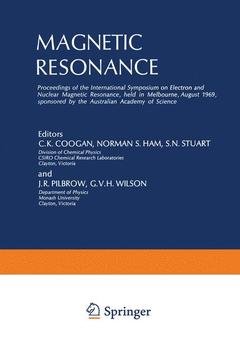Description
Magnetic Resonance, 1970
Proceedings of the International Symposium on Electron and Nuclear Magnetic Resonance, held in Melbourne, August 1969, sponsored by the Australian Academy of Science
Author: Coogan C. K.
Language: English
Subjects for Magnetic Resonance:
Publication date: 07-2012
386 p. · 17.8x25.4 cm · Paperback
386 p. · 17.8x25.4 cm · Paperback
Description
/li>Contents
/li>
TWENTY-FIVE years ago in Russia, Zavoisky made the first experimen tal observation of electron spin resonances; and a year later Purcell, Torrey and Pound at Harvard and Bloch, Hansen and Packard at Stanford ('The Harvard of the West') observed nuclear magnetic resonances for the first time. In both cases (ESR and NMR) the phenomena had been previously predicted, and Gorter - surely one of the most unlucky experimenters of our time - had made his noble attempts to detect magnetic resonances. Purcell et aZ. , having beaten their radar swords into scientific ploughshares, used a re 3 sonant coaxial cavity, filled the inductive part with 850 cm of paraffin, and produced a resonance with a signal-to-noise ratio of 20. They predicted that the sensitivity could be increased several hundred-fold and foresaw applications in determining magnetic mo ments, investigating spin-lattice coupling and measuring magnetic fields. Their letter reached the editor of Phys. Rev. on Christmas Eve 1945, and the basis of NMR in the solid state was laid. Bloch et aZ. , fortunately working independently, established the entirely different, crossed-coil approach to the observation of NMR in a water sample, which they doped with paramagnetic ions to reduce the relaxation times. They had laid the foundation of liquid-state NMR. Their letter to Phys. Rev. was received on 29 January 1946.
A Third of a Century of Paramagnetic Relaxation and Resonance.- N.M.R. Studies of Glasses and Related Crystalline Solids.- Charge Distributions in Ionic Crystals from the N.M.R. and N.Q.R. of Na and Cu.- Nuclear Magnetic Resonance in the Non-cubic Metals.- Hyperfine Interactions and Associated Properties of Alkali Metals.- Spin-Lattice Relaxation, Unstable Lattice Modes, and Critical Fluctuations.- An Information Theory of Line Shape in Nuclear Magnetic Resonance.- Nuclear Magnetic Resonance in Rapidly Rotating Solids.- Multiple-pulse N.M.R. Experiments and Averaging Effects.- Spin-flip Scattering of Electrons from Atoms Embedded in Metals.- Electron Spin Resonance in Dilute Magnetic Alloys.- E.P.R. Study of Nuclear Radiation Effects in CaWO4.- Optical, Paramagnetic and Endor Spectra of some Rare-earth Ions in CaF2.- Paramagnetic Resonance of Electronic States of Crystal Defects.- Gas-phase Electron Resonance Spectra of Linear Triatomic Free Radicals.- Studies of Rate and Equilibrium Processes by Nuclear Magnetic Resonance Spectroscopy.- Proton-decoupled Carbon-13 Magnetic Resonance.- On Nuclear Magnetic Resonance in Nematic Liquid Crystal Solvents.- Nuclidic Mass Measurement by Ion Cyclotron Resonance and Isotopic Abundance-ratio Measurement by Proton Resonance Satellites.- The Symposium Papers.
© 2024 LAVOISIER S.A.S.
These books may interest you

Annual Reports on NMR Spectroscopy 202.15 €



